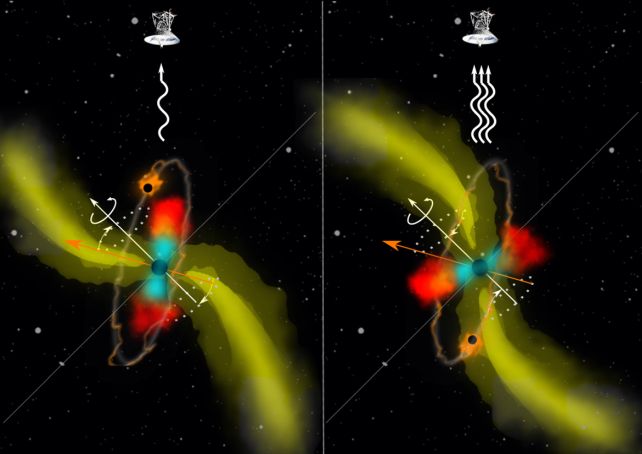Fluctuations in the light blazing from the brightest galaxies in the Universe could reveal a secret in their cores, astronomers say.
According to a new analysis of a type of galaxy known as a blazar, the best explanation for unusual changes in their glow is a pair of supermassive black holes locked in a decaying orbit.
Led by astronomer Silke Britzen of the Max Planck Institute for Radio Astronomy in Germany, an international team studied 12 blazar galaxies, finding an interpretation of circling black holes could be applied to all of them.
This could be a clue as to how supermassive black holes millions to billions of times the mass of the Sun grow to such tremendous size. A large number of supermassive black hole binaries would point to giant mergers throughout the history of the Universe.
"We present evidence and discuss the possibility that it is in fact the precession of the jet source, either caused by a supermassive binary black hole at the footpoint of the jet or – less likely – by a warped accretion disk around a single black hole, that is responsible for the observed variability," Britzen says.
The brightest known objects in the Universe are quasars – galaxies with a supermassive black hole in its center that is actively guzzling up material from a huge, hot disk that swirls around it like water down a drain.

A blazar is a type of quasar that is oriented in a certain way. As material swirls onto the black hole, some of it is diverted and accelerated along magnetic field lines outside the event horizon to the poles, where it is launched into space as jets of plasma approaching the speed of light. In blazar galaxies, one of those jets is pointed right at us.
But there's something curious about the light from blazars: it varies in its intensity. This has previously been interpreted as stochastic, or random, possibly the result of blobs of material being injected into the jets, causing what appears to be a flare.
A few years ago, Britzen and her colleagues showed the variability of blazar OJ 287 was the result of a precessing jet. That means the source of the jet is wobbling like a spinning top, causing the jet itself to curve and wobble too. We also know OJ 287 is host to two supermassive black holes; the precession is linked to their orbit.
OJ 287 is a bit of an extreme case; its variability is very pronounced. But using the same framework on 11 other blazars with less pronounced variability, as well as OJ 287, the researchers found that precession plays a significant role in their fluctuations.

Other processes, such as blobs and shocks, may also be present, but the underlying precession should not be ignored in explaining why the jets look the way they do, the researchers say.
"Physics of accretion disks and jets is rather complex but their bulk kinematics can be compared to simple gyroscopes," explains astrophysicist Michal Zajaček of the Masaryk University in Czechia.
"If you exert an external torque on an accretion disk, for instance by an orbiting secondary black hole, it will precess and nutate, and along with it the jet as well, similar to the Earth's rotation axis that is affected by the Moon and the Sun."
We currently lack instrumentation with the resolution to observe the disk architecture that would reveal these binary black holes, but continued monitoring of the precession, as well as long-term observation of other blazars, could continue to yield information about their existence.
"Jet precession seems to provide the best signature of these objects, whose existence is expected not only by the black hole / AGN community, but also from the gravitational wave / pulsar community who recently published evidence for the existence of a cosmic gravitational background due to the gravitational waves emitted by the mergers of massive black holes through cosmic history," says Britzen.
The research has been published in The Astrophysical Journal.
